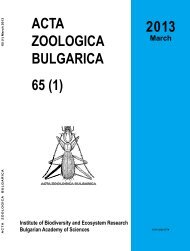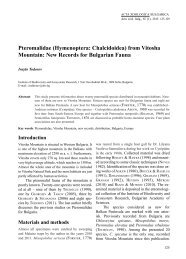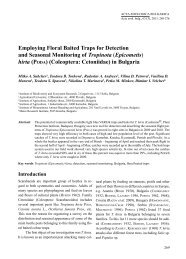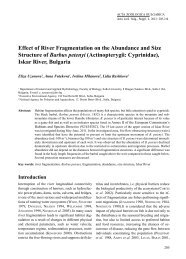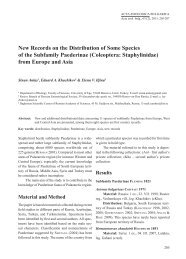Using Floral Baited Colour Traps for Detection and Seasonal ...
Using Floral Baited Colour Traps for Detection and Seasonal ...
Using Floral Baited Colour Traps for Detection and Seasonal ...
Create successful ePaper yourself
Turn your PDF publications into a flip-book with our unique Google optimized e-Paper software.
ACTA ZOOLOGICA BULGARICA<br />
Acta zool. bulg., 64 (4), 2012: 439-443<br />
<strong>Using</strong> <strong>Floral</strong> <strong>Baited</strong> <strong>Colour</strong> <strong>Traps</strong> <strong>for</strong> <strong>Detection</strong><br />
<strong>and</strong> <strong>Seasonal</strong> Monitoring of Oxythyrea funesta (Poda)<br />
(Coleoptera: Cetoniidae) in Bulgaria<br />
Mitko Subchev 1 , Teodora Toshova 1 , Radoslav Andreev 2 , Vilina Petrova 3 , Vasilina Maneva 4 ,<br />
Teodora Spasova 5 , Nikolina Marinova 5 , Petko Minkov, Dimitar Velchev 6<br />
1 Institute of Biodiversity <strong>and</strong> Ecosystem Research, 2 Gagarin str., 1113 Sofia, Bulgaria<br />
2 Agricultural University, 12 Mendeleev str., 4000 Plovdiv, Bulgaria<br />
3 Institute of Agriculture, Sofijsko shose, 2500 Kyustendil, Bulgaria<br />
4 Institute of Agriculture, 1 Industrialna str., 8400 Karnobat, Bulgaria<br />
5 Institute of Mountainous Animal Breeding <strong>and</strong> Agriculture, 281 Vasil Levski str., 5600 Troyan, Bulgaria<br />
6 Maize Research Institute, 5835 Knezha, Bulgaria<br />
Abstract: A new tool <strong>for</strong> detection <strong>and</strong> seasonal monitoring of Oxythyrea funesta (Po d a), floral baited colour traps, a<br />
commercial product of Plant Protection Institute, Center <strong>for</strong> Agricultural Research, HAS, Budapest, Hungary,<br />
was used <strong>for</strong> studying the distribution <strong>and</strong> patterns of seasonal appearance of the pest in eight sites<br />
in Bulgaria in 2009 <strong>and</strong> 2010. The most numerous catches of O. funesta were recorded in Plovdiv in both<br />
years <strong>and</strong> in Troyan in 2010. Catches ranging from 21 to 52 beetles were recorded also in Dryanovo, Karnobat,<br />
Kyustendil, Petrich <strong>and</strong> Troyan in 2009; Knezha <strong>and</strong> Troyan in 2010. In 2009 the earliest catches<br />
of O. funesta were recorded in Petrich <strong>for</strong> the period April 12 – April 20. In 2010 the first catches were recorded<br />
in Knezha <strong>for</strong> the period April 16 – April 22. The latest catches <strong>for</strong> the two years were recorded on<br />
September 6, 2010 in Troyan. The traps showed low selectivity especially in sites where another cetoniid<br />
pest, Tropinota (Epicometes) hirta (Po d a), attracted to the same traps, occurred.<br />
Key words: Oxythyrea funesta, detection, seasonal monitoring, Bulgaria, floral baited traps<br />
Introduction<br />
Oxythyrea funesta (Po d a) is a common species distributed<br />
through whole Europe from UK to Caucasus<br />
<strong>and</strong> from Sweden to Mediterranean region; it occurs<br />
also in North Africa <strong>and</strong> Asia Minor (Ba r a u d 1992).<br />
The species has been known in Bulgaria since the very<br />
beginning of XX century <strong>and</strong> it is widely distributed<br />
in this country (Ne d ya l k o v 1906, Bu r e s h, la z a r o v<br />
1956, Po P o va 1961, za h a r i e va 1965, za h a r i e vast<br />
o i l o va 1969, 1974, za h a r i e va, di m o va 1975).<br />
O. funesta is known as a polyphagous pest<br />
(hu r P i N 1962). The species was included in the list<br />
of harmful fauna of the apple orchards (tu c a et al.<br />
2009) <strong>and</strong> vineyards (sta N et al. 2009 ) in S. D. Banu<br />
Mărăcine, South Roumania. According to ra z o v et<br />
al. (2009) O. funesta together with some other cetoniid<br />
species can cause locally <strong>and</strong> economically<br />
important damage in peach orchards in Croatia.<br />
Pa d i y (1972) mentioned this species also as a <strong>for</strong>est<br />
pest. According to Po P o va (1961) O. funesta is<br />
a widely distributed pest in Bulgaria. She listed 24<br />
cultivated plant species <strong>and</strong> 12 wild plant species as<br />
hosts of the pest in this country (Po P o va 1961). Later<br />
Ni k o l o va (1968) reported O. funesta also as a permanent<br />
pest on Rosa x damascena Mill. in Bulgaria.<br />
Gr i G o r o v (1972) stated that O. funesta damages<br />
mainly vegetables <strong>and</strong> field crops but also orchards.<br />
When comparing traps of different colour<br />
to t h et al. (2005) found that O. funesta beetles are<br />
439
Subchev M., T. Toshova, R. Andreev, V. Petrova, V. Maneva, T. Spasova, N. Marinova, P. Minkov, D. Velchev<br />
attracted mostly to yellow <strong>and</strong> fluorescent yellow<br />
coloured traps. Later, as a result of intensive electrophysiological<br />
<strong>and</strong> field investigations, vu t s et al.<br />
(2008) described a binary bait <strong>for</strong> O. funesta comprising<br />
2 phenylethanol <strong>and</strong> (±)-lav<strong>and</strong>ulol. These<br />
findings leaded to the development of a floral baited<br />
colour traps <strong>for</strong> the pest which are offered as a commercial<br />
product <strong>for</strong> practical use by Plant Protection<br />
Institute, Budapest, Hungary.<br />
In 2009-2010 an extensive field work was organized<br />
in several regions in Bulgaria <strong>for</strong> proving<br />
the potential <strong>and</strong> species-specificity of floral baited<br />
colour traps as a new tool <strong>for</strong> detection <strong>and</strong> seasonal<br />
monitoring of some cetoniid pests. After publishing<br />
the results on Tropinota (Epicometis) hirta (Poda)<br />
(su B c h e v et al. 2011) here we report on the results<br />
obtained <strong>for</strong> O. funesta.<br />
Materials <strong>and</strong> Methods<br />
Commercially available VARb3k traps with a fluorescent<br />
yellow upper funnel <strong>and</strong> baits <strong>for</strong> O. funesta<br />
containing (±)-lav<strong>and</strong>ulol <strong>and</strong> 2-phenylethanol were<br />
purchased from Plant Protection Institute, Center<br />
<strong>for</strong> Agricultural Research, HAS, Budapest, Hungary<br />
<strong>and</strong> used in our field work. Two traps (together with<br />
two traps <strong>for</strong> each T. hirta <strong>and</strong> Cetonia aurata L./<br />
Protaetia (Netocia) cuprea (Fa B r i c i u s)) were set in<br />
8 sites in Bulgaria (Dryanovo, Gabrovo, Karnobat,<br />
Knezha, Kyustendil, Petrich, Plovdiv <strong>and</strong> Troyan) in<br />
2009 <strong>and</strong>/or 2010 covering all flight period of the<br />
pest (<strong>for</strong> details see su B c h e v et al. 2011). The traps,<br />
installed on the ground or at a height of 50-100 cm<br />
above the ground level, were visited weekly <strong>and</strong> the<br />
beetles caught were collected <strong>and</strong> identified in laboratory<br />
using Ba r a u d (1992) <strong>and</strong> me d v e d e v (1965).<br />
Only in Gabrovo the traps were visited irregularly at<br />
10-15 day intervals.<br />
Results<br />
The most numerous catches of O. funesta were recorded<br />
in Troyan in 2010 <strong>and</strong> Plovdiv in both 2009<br />
<strong>and</strong> 2010. Catches ranging from 21 to 52 were recorded<br />
also in Dryanovo, Karnobat, Kyustendil,<br />
Petrich <strong>and</strong> Troyan in 2009; Knezha <strong>and</strong> Troyan in<br />
2010. A drastical increase of the population level of<br />
the pest estimated by the catches was observed in<br />
Troyan in 2010 as compared to 2009 (Table 1).<br />
The seasonal flight of O. funesta as established<br />
by catches in the traps is presented in Fig 1. Because<br />
440<br />
of absence of catches in Dryanovo <strong>and</strong> realatively<br />
low number of beetles caught in Dryanovo (2009,<br />
2010), Karnobat (2010), Kyustendil (2009, 2010)<br />
<strong>and</strong> Petrich (2010), no figures are presented <strong>for</strong> these<br />
sites <strong>and</strong>/or years. Not regular checking the catches in<br />
Gabrovo in 2009 also does not allow a correct presentation<br />
of the flight of the pest at that site. In 2009<br />
the earliest catches of O. funesta were recorded in<br />
Petrich on April 20 which means that the beetles were<br />
caught between April 12 (the previous check of the<br />
traps) <strong>and</strong> April 20 (not presented). In 2010 the first<br />
catches were recorded in Knezha <strong>for</strong> the period April<br />
16 – April 22. The latest catches <strong>for</strong> the two years<br />
were recorded on September 6, 2010 in Troyan. Even<br />
in the sites with the most numerous beetles caught,<br />
the data do not allow to speculate about presence of<br />
any peaks – the presence of some fluctuations in the<br />
catches were due most probably to meteorological<br />
variables like air temperature <strong>and</strong> rain falls <strong>and</strong> not to<br />
real changes in the population level.<br />
The percentage of the catches of different species<br />
caught in the sites <strong>and</strong> years with most numerous<br />
catches are presented in Fig. 2. Only in Troyan<br />
in 2009 <strong>and</strong> 2010, <strong>and</strong> in Plovdiv in 2009 the catches<br />
of O. funesta exceeded 80% of all cetoniid beetles<br />
caught in the same traps. Relatively high percentage<br />
of the target species caught in the traps varying 28-<br />
40% was found also in Dryanovo in 2009 (not presented),<br />
Karnobat in 2009 <strong>and</strong> Plovdiv in 2010. The<br />
non target species attracted <strong>and</strong> caught into O. funesta<br />
traps in the highest percentage was T. hirta. In<br />
five from the twelve cases this percentage exceeded<br />
90%. The other not target scarabaeid species caught<br />
in O. funesta traps were: C. aurata, P. cuprea, Valgus<br />
hemipterus (L.), Blitopertha lineolata (Fi s c h e r v o N<br />
Wa l d h e i N) <strong>and</strong> T. fasciatus (L.).<br />
Discussion<br />
As a faunistic object O. funesta was found in different<br />
regions of Bulgaria: Thrace (za h a r i e va 1965), west<br />
Balkans (za h a r i e va-st o i l o va 1969), middle <strong>and</strong> east<br />
Balkans (za h a r i e va-st o i l o va 1974, the Rhodopes<br />
(za h a r i e va, di m o va 1975. According to Po P o va<br />
(1961) the pest has a general distribution in Bulgaria.<br />
Our catches of O. funesta at all eight sites included in<br />
the present investigations support the latter statement.<br />
In addition our data showed also that in the sites where<br />
observations were organized the population level of<br />
the pest was relatively low or very low.
<strong>Using</strong> floral baited colour traps <strong>for</strong> detection <strong>and</strong> seasonal monitoring of Oxythyrea funesta...<br />
Table 1. Catches of O. funesta in two target traps in each of eight sites in Bulgaria during 2009 <strong>and</strong> 2010<br />
- – test not per<strong>for</strong>med.<br />
Site<br />
During a three year period of observations<br />
(1957-1959) around Sofia <strong>and</strong> using field observations<br />
(no details were given) <strong>and</strong> the case method,<br />
Po P o va (1961) established the earliest flying O. funesta<br />
beetles in autumn on April 17, 1959 <strong>and</strong> the<br />
latest ones on August 26, 1959. The maximum flight<br />
period May 16/22 – June 1/6 given in the same paper<br />
was not supported by concrete data. Our present<br />
results on seasonal flight of O. funesta obtained by<br />
using the new precise tool – floral baited colour traps<br />
confirm as a whole Po P o va’s (1961) observations. In<br />
addition our data showed a longer flying period – up<br />
to the first days of September.<br />
At four from eight sites in Hungary, Croatia,<br />
Italy <strong>and</strong> Bulgaria investigated O. funesta was<br />
caught in percentage ranging from 87% to 35% in<br />
target yellow traps baited with (±)-lav<strong>and</strong>ulol <strong>and</strong><br />
2-phenylethanol. In the rest of the sites this percentage<br />
was lower or no catches of the target species<br />
were observed (vu t s et al. 2010). As a whole our<br />
results support this finding but the species selectivity<br />
of the same traps used was even lower. The low<br />
selectivity of the traps <strong>for</strong> O. funesta to the target<br />
species in our present investigations is due exclusively<br />
on the catches of T. hirta. tot h et al. (2005)<br />
reported that the beetles of the latter species preferred<br />
blue coloured unbaited traps in comparison<br />
with transparent, white, yellow <strong>and</strong> fluorescent<br />
yellow traps. However, other field tests showed no<br />
significant differences in the catches of T. hirta in<br />
white, light blue <strong>and</strong> yellow unbaited traps although<br />
again the highest catches were recorded in the blue<br />
traps (sc h m e r a et al. 2004). There is no any overlapping<br />
in the commercial Csalomon ® baits used<br />
Total number of beetles caught<br />
2009 2010<br />
Dryanovo 25 0<br />
Gabrovo 13 -<br />
Karnobat 46 1<br />
Knezha - 52<br />
Kyustendil 22 4<br />
Petrich 21 -<br />
Plovdiv 99 108<br />
Troyan 35 439<br />
<strong>for</strong> these two species in our work: (±)-lav<strong>and</strong>ulol<br />
<strong>and</strong> 2-phenylethanol <strong>for</strong> O. funesta <strong>and</strong> (E)-anethol<br />
<strong>and</strong> (E)-cinnamyl alcohol <strong>for</strong> T. hirta (vut s et al.<br />
(2010). Thus the explanation <strong>for</strong> the exclusively<br />
high catches of T. hirta in O. funesta traps in our<br />
present investigations could be explained by colour<br />
attracting <strong>and</strong> the absence of repellency of any of<br />
the components in O. funesta bait to T. hirta beetles.<br />
Moreover, one of these components, 2-phenylethanol,<br />
elicited an electrantennographic response on<br />
both males <strong>and</strong> female antenna of T. hirta not significantly<br />
different from that elicited by (E)-anethol,<br />
a bait component of this species (vu t s et al. 2010),<br />
<strong>and</strong> also showed some attractivity toward the species<br />
in field (to t h et al. (2003). Thus, most probably this<br />
leaded to almost equal catches of T. hirta in the target<br />
traps <strong>for</strong> this species <strong>and</strong> in O. funesta traps, e.g.<br />
274 <strong>and</strong> 271 beetles respectively in Troyan, in 2010,<br />
or even to higher catches of T. hirta in O. funesta<br />
traps in comparison to the catches in the target T.<br />
hirta traps, e.g. 2628 <strong>and</strong> 1408 beetles respectively<br />
in Knezha in 2010 (Fig. 2 in the present paper <strong>and</strong><br />
suB c h e v et al. 2011).<br />
Our results allow to conclude that fluorescent<br />
yellow floral baited traps <strong>for</strong> O. funesta, commercial<br />
product of Plant Protection Institute, Budapest,<br />
Hungary, is effective tool <strong>for</strong> detection <strong>and</strong> seasonal<br />
monitoring of this pest. However its selectivity is<br />
low especially in sites where the population level of<br />
another cetoniid pest, T. hirta, is high.<br />
Acknowled+gments: Thanks are due to Ms Petya Trayanova, Mr<br />
Kircho Trayanov, Mr Vasilii Abaev <strong>and</strong> Ms Silvia Terziiska <strong>for</strong><br />
technical assistance in the field work. This project was supported<br />
by Grant DO02-244/2008 of Bulgarian National Scientific Fund.<br />
441
Subchev M., T. Toshova, R. Andreev, V. Petrova, V. Maneva, T. Spasova, N. Marinova, P. Minkov, D. Velchev<br />
Fig. 1. <strong>Seasonal</strong> flight of O. funesta in four sites in Bulgaria. Arrows (↓) show the dates of installing <strong>and</strong> reinstalling<br />
the traps in the field. Asterisks (*) mark the date when the baits were renewed.<br />
Fig. 2. Percentage distribution of scarabaeid beetles caught in traps with baits <strong>for</strong> O. funesta at four sites in Bulgaria<br />
in 2009-2010.<br />
442<br />
Mean number ± SE<br />
Mean number ± SE<br />
Mean number ± SE<br />
10<br />
8<br />
6<br />
4<br />
2<br />
0<br />
14<br />
12<br />
10<br />
8<br />
6<br />
4<br />
2<br />
0<br />
6<br />
5<br />
4<br />
3<br />
2<br />
1<br />
0<br />
Karnobat, 2009, total catch: 46 beetles<br />
25.03.<br />
31.03.<br />
06.04.<br />
13.04.<br />
21.04.<br />
27.04.<br />
04.05.<br />
11.05.<br />
18.05.<br />
25.05.<br />
01.06.<br />
08.06.<br />
15.06.<br />
22.06.<br />
29.06.<br />
06.07.<br />
13.07.<br />
20.07.<br />
27.07.<br />
03.08.<br />
10.08.<br />
17.08.<br />
24.08.<br />
31.08.<br />
Plovdiv, 2009, total catch: 99 beetles<br />
*<br />
*<br />
*<br />
*<br />
27.03.<br />
31.03.<br />
03.04.<br />
10.04.<br />
17.04.<br />
24.04.<br />
01.05.<br />
08.05.<br />
15.05.<br />
22.05.<br />
29.05.<br />
05.06.<br />
12.06.<br />
19.06.<br />
26.06.<br />
03.07.<br />
10.07.<br />
17.07.<br />
24.07.<br />
31.07.<br />
07.08.<br />
14.08.<br />
21.08.<br />
28.08.<br />
Date<br />
Troyan, 2009, total catch: 35 beetles<br />
* *<br />
*<br />
24.03.<br />
30.03.<br />
07.04.<br />
13.04.<br />
21.04.<br />
27.04.<br />
04.05.<br />
11.05.<br />
18.05.<br />
25.05.<br />
01.06.<br />
08.06.<br />
15.06.<br />
22.06.<br />
29.06.<br />
06.07.<br />
13.07.<br />
20.07.<br />
27.07.<br />
03.08.<br />
10.08.<br />
17.08.<br />
24.08.<br />
31.08.<br />
06.09.<br />
13.09.<br />
20.09.<br />
57%<br />
*<br />
*<br />
Date<br />
*<br />
Date<br />
* * *<br />
*<br />
3% 3% Karnobat, 2009<br />
37%<br />
*<br />
C. aurata<br />
*<br />
O. funesta<br />
T. hirta<br />
V. hemipterus<br />
14% 1%<br />
Plovdiv, 2009<br />
85%<br />
C. aurata<br />
O. funesta<br />
T. hirta<br />
4% 4%<br />
Troyan, 2009<br />
92%<br />
C. aurata<br />
O. funesta<br />
P. cuprea<br />
Mean number ± SE<br />
Mean number ± SE<br />
Mean number ± SE<br />
10<br />
8<br />
6<br />
4<br />
2<br />
0<br />
14<br />
12<br />
10<br />
8<br />
6<br />
4<br />
2<br />
0<br />
70<br />
60<br />
50<br />
40<br />
30<br />
20<br />
10<br />
0<br />
Knezha, 2010, total catch: 52beetles<br />
26.03.<br />
02.04.<br />
08.04.<br />
16.04.<br />
22.04.<br />
29.04.<br />
05.05.<br />
14.05.<br />
21.05.<br />
28.05.<br />
04.06.<br />
11.06.<br />
18.06.<br />
25.06.<br />
02.07.<br />
09.07.<br />
16.07.<br />
22.07.<br />
29.07.<br />
06.08.<br />
13.08.<br />
20.08.<br />
27.08.<br />
Plovdiv, 2010, total catch: 108beetles<br />
*<br />
26.03.<br />
30.03.<br />
06.04.<br />
13.04.<br />
20.04.<br />
27.04.<br />
04.05.<br />
11.05.<br />
18.05.<br />
25.05.<br />
01.06.<br />
08.06.<br />
15.06.<br />
22.06.<br />
29.06.<br />
06.07.<br />
13.07.<br />
20.07.<br />
27.07.<br />
03.08.<br />
10.08.<br />
17.08.<br />
25.08.<br />
*<br />
Date<br />
Troyan, 2010, total catch: 439 beetles<br />
*<br />
*<br />
*<br />
*<br />
*<br />
*<br />
Date<br />
24.03.<br />
30.03.<br />
06.04.<br />
12.04.<br />
19.04.<br />
26.04.<br />
03.05.<br />
10.05.<br />
17.05.<br />
25.05.<br />
31.05.<br />
07.06.<br />
14.06.<br />
21.06.<br />
28.06.<br />
05.07.<br />
12.07.<br />
19.07.<br />
26.07.<br />
02.08.<br />
09.08.<br />
16.08.<br />
23.08.<br />
30.08.<br />
06.09.<br />
13.09.<br />
20.09.<br />
70%<br />
*<br />
Date<br />
0.04% 0.3% Knezha, 2010<br />
1.9%<br />
0.2%<br />
1.8%<br />
97.8%<br />
2% Plovdiv, 2010<br />
28%<br />
0.2% 0.2%<br />
97.6%<br />
*<br />
*<br />
*<br />
*<br />
*<br />
O. funesta<br />
T. hirta<br />
C. aurata<br />
V. hemipterus<br />
*<br />
O. funesta<br />
T. hirta<br />
P. cuprea<br />
Troyan, 2010<br />
C. aurata<br />
O. funesta<br />
T. hirta<br />
P. cuprea<br />
V. hemipterus
References<br />
<strong>Using</strong> floral baited colour traps <strong>for</strong> detection <strong>and</strong> seasonal monitoring of Oxythyrea funesta...<br />
Bar a u d J. 1992. Coléoptères Scarabaeoidea d´Europe. Faune<br />
de France, vol. 78. Féderation Française des Societés de<br />
Sciences Naturelles. Lyon, 856 p.<br />
Bu r e s h i., a. la z a r o v 1956. Vrednite nasekomi za selskoto i<br />
gorskoto stopanstvo v Balgariya. Agricultural <strong>and</strong><br />
<strong>for</strong>est insect pests in Bulgaria. Balgarska Akademiya<br />
na naukite, Sofia, 289 p. (In Bulgarian).<br />
Gr i G o r o v s. 1972. Specialna entomologiya. Special entomology.<br />
Sofia, Zemizdat, 592 p. (In Bulgarian).<br />
hu r P i N B. 1962. Super-famille des Scarabaeoidea. – In: A. S.<br />
Balachowsky (Ed.): Entomologie appliquée á l’agriculture.<br />
Masson et Cie Éditeurs, Paris, 24-204.<br />
me d v e d e v S. I. 1965. Semejstvo Scarabaeidae. Family<br />
Scarabaeidae. – In: G. Y. Bey-Bienko (Ed.):<br />
Opredelitel’ hasekomyh evropejskoj chasti SSSR.<br />
Vol. 2. Coleoptera i Strepsiptera. Nauka, Moskva-<br />
Leningrad, 166-208. (In Russian).<br />
Ne d ya l k o v, N. 1906. Prinos kam entomologichnata fauna na<br />
Balgariya. A contribution to the entomological fauna<br />
of Bulgaria. – Periodichno spisanie na Balgarskoto<br />
knizhovno druzhestvo, XVI: 404-439. (In Bulgarian).<br />
Po P o va v. 1961. Oxythyrea funesta Poda. Biologie und Bekampfungsversuche.<br />
– Izvestuiya na centralniya nauchno-izsledovatelski<br />
institut po zashtita na rasteniyata. 1: 315-331.<br />
(In Bulgarian, German summary).<br />
Ra ž o v, Jo s i p, Bo ž e n a Ba R i ć, Mo R e n o Du t t o. 2009. Fauna of<br />
cetoniid beetles (Coleoptera: Cetoniidae) <strong>and</strong> their damages<br />
on peach fruits in orchards of northern Dalmatia, Croatia. –<br />
Entomol. Croat., 13 (2): 7-20<br />
Ni k o l o va v. 1968. Entomotsenologichni i biologichni<br />
prouchvaniya v nasazhdeniya s maslodajna roza.<br />
II. Coleoptera. Entomological <strong>and</strong> biological<br />
investigations in Damask rose fields – Izvestiya na<br />
zoologicheskiya institut s muzej, 26: 119-155. (In<br />
Bulgarian, with Russian summary).<br />
Pa d i y, N. N. 1972. Kratkij opredelitel’vreditelej lesa. Short key<br />
of <strong>for</strong>est pests. Moskva. Izdatel’stvo “Lesnaya promyshlennost”,<br />
288 p. (In Russian).<br />
sc h m e r a d., m. tó t h, m. su B c h e v, i. sr e d k o v, i. sz a r u k á N, t.<br />
Je R M y , Á. szentesi 2004. Importance of visual <strong>and</strong> chemical<br />
cues in the development of an attractant trap <strong>for</strong> Epicometis<br />
(Tropinota) hirta Poda (Coleoptera: Scarabaeidae). – Crop<br />
Prot., 23: 939-944.<br />
sta N, cat a l iN , ov i d i u tu c a, io N mi t r e a. 2009. The spectrum<br />
of harmful arthropod fauna from the vineyard S.D. Banu<br />
Maracine – Craiova. – In: 44th Croatian & 4th International<br />
Symposium on Agriculture. February 16-20, 2009, Opatija,<br />
Croatia. Proceedings, 876-879.<br />
su B c h e v, m. a., te o d o r a B. to s h o va, ra d o s l av a. aN d r e e v,<br />
viliNa d. Pe t r o va, va s i l i N a d. ma N e va, te o d o r a s. sPas<br />
o va , Ni k o l i N a t. ma r i N o va, Pe t k o m. mi N k o v, dimitar i.<br />
ve l c h e v 2011. Employing floral baited traps <strong>for</strong> detection<br />
<strong>and</strong> seasonal monitoring of Tropinota (Epicometis) hirta<br />
(Poda) (Coleoptera: Cetoniidae) in Bulgaria. – Acta zool.<br />
bulg., 63, 3: 269-276.<br />
tó t h m., m. G. kleiN, z. im r e i 2003. Field screening <strong>for</strong> attractants<br />
of scarab pests in Hungary (Coleoptera: Scarabaeidae). –<br />
Acta Phytopath. Entomol. Hung., 38: 323-331.<br />
tó t h M., z. iM R e i, i. sz a R u k Á n, e. vo i g t, D. sc h M e R a, J. vu t s, k.<br />
ha r m i N c z, m. su B c h e v 2005. Gyümölcs- ill. virágkárokat<br />
okozó cserebogárfélék kémiai kommunikációja: egy<br />
évtized kutatási eredményei. - Növényvédelem, 41: 581-588<br />
(in Hungarian, English Summary).<br />
tu c a o., i. mi t r e a, c. sta N 2009. Spectrun of the harmful<br />
fauna from the S. D. Banu Maracine apple orchards. –<br />
Universitatea din Craiova. Seria: Biologie, Horticultură,<br />
Tehnologia prelucrării produselor agricole, Ingineria<br />
mediului, XIV (XLX): 2009 385-388.<br />
vu t s, J., z. iM R e i, M tó t h. 2008. Development of an attractantbaited<br />
trap <strong>for</strong> Oxythyrea funesta Poda (Coloeptera: Scarabaeidae,<br />
Cetoniinae). – Z. Natur<strong>for</strong>sch., 63c: 761-768.<br />
vu t s J., B. Ba R i c, J. Ra z o v, t. B. to s h o va, M. su B c h e v, i. sR e D k o v,<br />
r. taBilio, F. diFr a N c o, m. tó t h 2010. Per<strong>for</strong>mance <strong>and</strong><br />
selectivity of floral attractant-baited traps targeted <strong>for</strong> cetoniin<br />
scarabs (Coleoptera: Scarabaeidae) in Central <strong>and</strong><br />
Southern Europe. – Crop Prot., 29: 1177-1183.<br />
za h a r i e va l. 1965. Scarabaeidae (Coleoptera) aus Thrakien. In:<br />
Fauna of Thracia. Sofia, Bulgarian Academy of Sciences,<br />
Institute of Zoology, 229-254. (In Bulgarian, German<br />
Summary).<br />
zah a r i e va-st o i l o va B. 1969. Forschungen über Scarabaeidae<br />
(Coleoptera) in westlische Stara-planina – Gebirge. –<br />
Bulletin de l’institut de zoologie. Tome XXX: 5-36. (In<br />
Bulgarian, German Summary).<br />
za h a r i e va-st o i l o va B. 1974. Scarabaeidae von dem mittleren<br />
und dem östlichen Balkangebirde. – Bulletin de l’institut<br />
de zoologie. Tome XLI: 123-139 (In Bulgarian, German<br />
Summary).<br />
za h a r i e va B., v. di m o va 1975. Faunistische Untersuchungen über<br />
die Scarabaeidae (Coleoptera) aus deb Rhodopen. – In: La<br />
faune des Rhodopes. Materiaux. Sofia, Bulgarian Academy<br />
of Sciences. 183-196. (In Bulgarian, German Summary).<br />
Received: 01.03.2012<br />
Accepted: 18.04.2012<br />
443


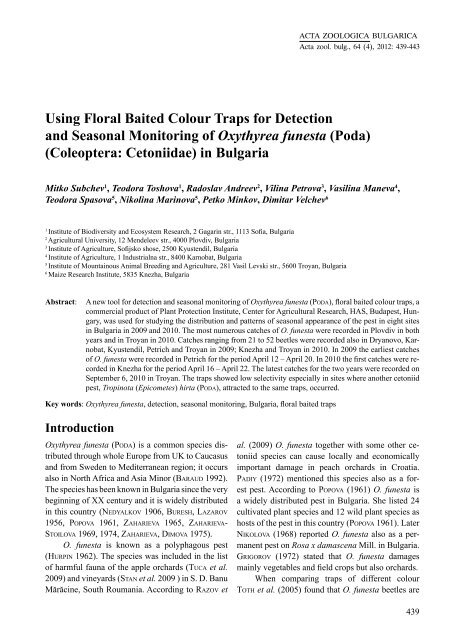
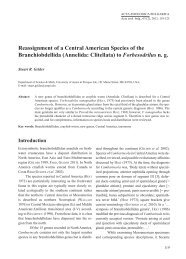
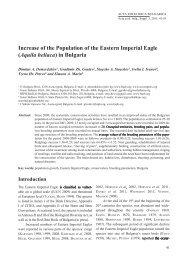
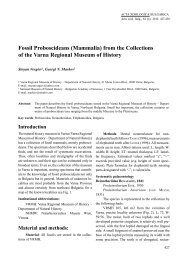
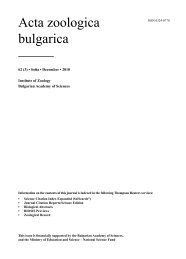
![table of contents [PDF] - Acta zoologica bulgarica](https://img.yumpu.com/52655254/1/186x260/table-of-contents-pdf-acta-zoologica-bulgarica.jpg?quality=85)
![table of contents [PDF] - Acta zoologica bulgarica](https://img.yumpu.com/52655255/1/186x260/table-of-contents-pdf-acta-zoologica-bulgarica.jpg?quality=85)
